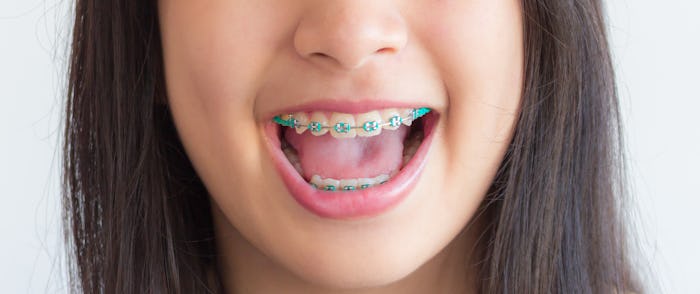Life

Kids Can Get Braces At A Surprisingly Young Age If Necessary
You’ve adored your child’s goofy grin since forever. Then, those beautiful little baby teeth fall out and in come the permanent ones. If your kid’s teeth begin to grow in crooked or flaring, you might find yourself thinking about correcting that dental dilemma. So how young can your child get braces if it turns out they might need it not only for a straight smile, but also help the way they might eat and speak.
"The American Association of Orthodontics (AAO) recommends that children have their first orthodontic consultation at the age of seven,” Dr. Erika Faust, an orthodontist at Elite Orthodontics in New York City, tells Romper. “By this age, your child’s first adult molars have appeared and her permanent bite has been established. So, if there is any deviation from a normal bite we can take steps to correct it early.” Of course, there are some exceptions to this rule, such as correcting a thumb-sucking habit or for a patient who might need to learn proper tongue placement while swallowing, reported the American Association of Orthodontics (AAO).
During an initial visit, there are some things that orthodontists look for to see if getting braces at an early age might be necessary. “At the first consultation, we determine if there are any severe bite or alignment issues that need to be immediately addressed, and if so, we begin treatment,” says Dr. Faust. “In many cases, more moderate orthodontic treatment is recommended and the patient can wait until most baby teeth have come out.” That said, an early intervention procedure might be performed prior to getting braces, such as removing a baby tooth, so that a permanent tooth can take its place. Orthodontists also evaluate for proper tooth development and eruption to make sure that all of the permanent teeth are coming in properly. That’s why taking your child to the orthodontist for an initial appointment sooner rather than later can help determine if early intervention methods might be necessary.
In most cases, braces go on around ages 11-13. At this point, pretty much all of your child’s baby teeth will have fallen out and he’ll have his permanent ones. And that’s when you might start seeing superficial issues, like crowding or crooked teeth. But there’s a small window when orthodontics will work, and that’s mostly due to your child's age and attitude. “Starting treatment later than ages 11-13 risks poorer patient cooperation and the likelihood that treatment won’t be finished before important life events like senior pictures, prom, and graduation,” explains Dr. Faust. That's why it's best for your child to brace himself (ha) and get braces before becoming a full-blown teenager.
But having straight teeth isn’t the only end goal of electing to get braces. Proper orthodontic treatment can allow your child to chew and eat correctly as well as speak more clearly. “Jaw discrepancies are corrected much easier and faster in growing children than in adults,” says Dr. Faust. “Neglecting these issues can result in the need for a much longer time in braces in adolescence, extraction of permanent teeth, and in severe cases, jaw surgery later in life.”
Getting braces is almost a rite of passage in the tween years. While most children should be assessed during their elementary school years, middle school is often when many kids begin orthodontic treatment. And before you know it, your child's smile will be picture-perfect once again.
This article was originally published on